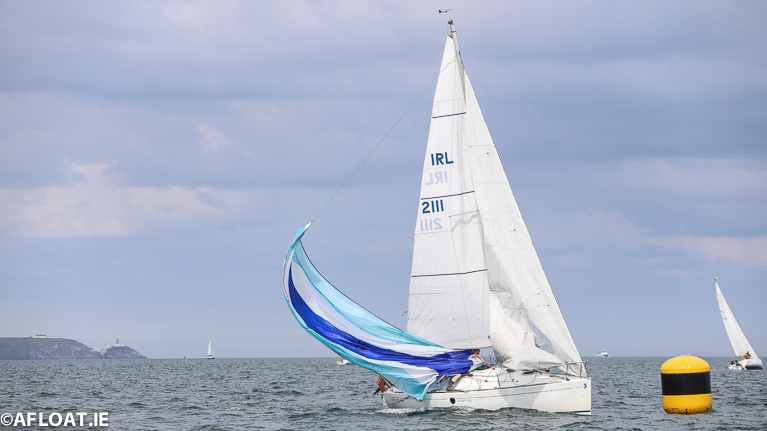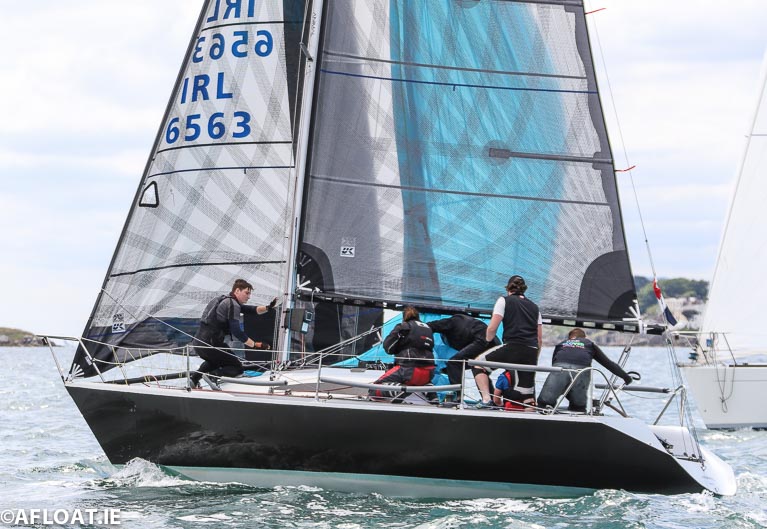We all know sailing fast in a straight line is very important. That is where, as sailmakers, our products shine and our technical background can be leveraged for your benefit writes Graham Curran. But races are won and lost at the corners. You can be the fastest boat on the water but if your critical manoeuvres are not dialled in then one bad hoist or drop could have your advantage erased immediately.
Let’s take a look at look at leeward mark rounding techniques and present some top tips for perfecting your manoeuvres. With that said; there is a lot going on at the leeward mark with a lot of elements in play, including conditions, spinnaker setup, boat size, course layouts etc, so this list is no means exhaustive, but if you can work on these general points then you will be many steps closer to that elusive perfect leeward mark rounding.
 A leeward mark at July's Volvo Dun Laoghaire Regatta Photo: Afloat
A leeward mark at July's Volvo Dun Laoghaire Regatta Photo: Afloat
We are going to break our tips into light air tips and heavy air tips. As we will see, the wind speed plays a major role in how you should approach your drops.
Light Airs
- Keep your spinnaker flying as long as possible. In light airs, it is easy to be over-cautious with your spinnaker drops – dropping the spinnaker early and slowing boat speed significantly. We need to keep the spinnaker driving the boat for as long as possible to get us to the leeward mark at maximum speed. As the wind is light we will have plenty of time to get the sail down as we turn around the mark.
- Partially hoist your jib but not so much that it affects the spinnaker. Getting the jib up is good, you’re certainly going to need it, but timing is everything. When the jib is in the air it immediately begins effecting the airflow onto and across the spinnaker with the potential to collapse it early – we’ve all been there and it isn’t fast. Half hoist the jib so the first couple of battens are clear of the guard rails – this keeps the spinnaker clear while also ensuring there are no issues with the jib hoist itself. Once the drop (and the mark) are imminent – hoist the jib fully. Make sure the jib sheet is loose. This will help keep the kite going to the very last second. When rounding trim the jib constantly as the boat turns – do not ram it in early to save yourself some grinding on the other side!
- Manage your crew weight. I cannot stress this point enough – especially in light airs. Once the spinnaker is down and not in the water – sit down. Get to leeward if the conditions require it and stop moving. The best drops can be ruined by a bouncy crew on the deck. At this point, it is critical for the boat to build speed and exit the mark as fast as possible. Generally, at this point we are trying to escape the fleet or get to the favoured side – boat speed is of utmost importance. An over-eager bow crew preparing for a windward mark that is 40 minutes away is simply not helpful. Sit down, settle, let the boat accelerate, and then pick your time to do your jobs.
- Keep your trimmer focused. There is a lot going on at the leeward mark. Boats approaching, likely plenty of shouting, sails going up and down. It is critical for your spinnaker trimmer to stay 100% focused at this point. As the jib goes up the spinnaker behaviour will change and trim will need to be adjusted to keep it drawing. Active trimming here is worth its weight in gold. As the old saying goes – “if in doubt, leave it out”.
- Plan ahead to optimize your crew work. Ideally you want to drop the spinnaker on the side which it will hoisted at the next mark. This is not always possible but it is what we should be aiming for. This results in less work for your bow team and pit crew, which means less running of gear, more weight effectively placed for longer. Know your course and know what drop option will suit you best – then try to make it happen.
 A Spinnaker drop at a leeward mark in a Beneteau 211 Photo: Afloat
A Spinnaker drop at a leeward mark in a Beneteau 211 Photo: Afloat
Heavy Airs
- 1. Manage the spinnaker halyard. It should go without saying that the spinnaker halyard should be flaked and ready to run. The pit crew, when the drop is called, should smoke ¼ of the spinnaker halyard to instantly depower the sail and allow the bow crew to get a good handful of the sail into the boat. Once this is done the halyard should then be eased gradually to ensure the sail does not end up in the water. The faster this first portion of the halyard is blown the better – you want to shock the spinnaker into submission!
- Get the pole away early. In moderate/heavy airs there is plenty of pressure in the spinnaker to keep it set. The pole can be cleared early to make the drop much cleaner and give you more options for manoeuvring during and after the drop. If flying a symmetric spinnaker use a crew member to “human guy” the spinnaker to help the trimmer maintain control. If flying an asymmetric spinnaker “clearing the pole” is as simple as un-cleating the pole outhaul rope before the drop so that when the spinnaker unloads and is being recovered the pole is automatically pulled in – just keep an eye on your tackline so it doesn’t go under the bow!
- Get hiking! Similar to light airs, crew weight management is crucial. Get the weight on the rail as soon as possible. If the kite isn’t at risk of going in the water and the boat is clear to tack then your weight should be hiking – not tidying. There is an entire windward leg to prepare for the next hoist or coil your sheets. Hike first, housekeep later.
- Drop early and gain. Much the opposite of the above – push to your limits, not beyond them. An early drop doesn’t hurt boat speed significantly in a heavy air situation – having the spinnaker still in the air as your turn upwind however very much does. Get the spinnaker down early and safely and get the crew to where they need to be as you turn the corner.
- Avoid a leeward drop. In heavy airs, leeward drops are just asking for trouble. Sometimes it is unavoidable but if at all possible use any other option.
Put in the time

“Time on the water is king” – there is no denying this. The more you and your crew sails together the better your manoeuvres will be. And its time well worth spending. Put in the practice before racing begins and give yourselves time to learn.
On top of this – know your limits. It is tough, when in the heat of battle, to take a step back and assess the situation. It is crucial to know what you are capable of as a crew. This will allow you to push your drops to the limit, but not beyond them, and by doing so you will gradually improve as the manoeuvre becomes smoother.
Get out on the water and make the most of the upcoming Autumn Series! See you on the water!



























































